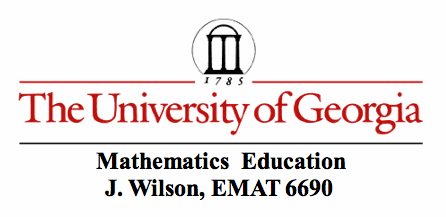
Tangential Circles
by
Nancy Perzel
Two larger circles with equal radii pass through each other's centers. A smaller circle can be created inside the overlapping region so that it is tangent to the other circles. (Tangent means that the circles touch each other but do not cross over each other, nor do they leave any gaps.) Compare the area and circumference of the smaller circle to the area and circumference of the larger circle.
http://intermath.coe.uga.edu/topics/geometry/circles/r01.htm
To construct the Tangential Circles using GeometerŐs Sketchpad:
1) Construct a circle, A
2) Plot a point, B, on circle A
3) Using the center (point A) and point B, construct a segment, this is the radius of circle A.
4) Select point B and the radius (segment from step 3) to construct a circle by Center+Radius
5) Select the radius, AB, and construct a midpoint
6) Label this point C
7) Select point A and C – construct a segment, this will be the radius of the smaller circle.
8) Select point C and A to construct a circle by Center+Point. This circle will be tangent to both circles A and B.
The original problem instructs us to "compare the area and circumference of the smaller circle to the area and circumference of the larger circle."
We can begin making observations using the image above which reveals a relationship between the radius of the smaller circle (AC=2.58 cm) and the radius of the larger circle (AB=5.17 cm) at a ratio of 1:2. In other words, the radius of the smaller circle is one-half the radius of the larger circle.
Let's look below for a further investigation in the relationship between the circles.
This image provides data for further observations regarding the relationship between the smaller circle (C) and the larger circle (A and/or B).
The one-dimensional features (circumference) can be compared using a 1:2 ratio between the smaller circle and the larger circle(s). In other words, the circumference of circle C is one-half the circumference of circles A and/or B.
The two-dimensional features (area) can be compared using a 1:4 ratio between the smaller circle and the larger circle(s). In other words, the area of circle C is one-fourth the area of circles A and/or B.
A difference occurs when we make a comparison between the two features because circumference is measured in linear units and area is measured in square units.
Click here to open the GSP file and manipulate the sketch using the Animation feature. As you run the animation on page 3 of the GSP sketch you will see this relationship hold true for all circles.
Extension:
How do the results change if the two larger circles do not have equal radii?
In the example below circle B was constructed first, making it the original circle. Circle A was constructed using one-half of the length of the radius from circle B. Circle D is tangent to circles B and A.
I will compare the change in values by focusing on the relationship between two circles at a time:
circle A & circle B
ratio of circumference 1:2, in other words, the circumference of circle A is one-half the circumference of circle B
ratio of area 1:4, in other words, the area of circle A is one-fourth the area of circle B
circle D & circle A
ratio of circumference 1:2, in other words, the circumference of circle D is one-half the circumference of circle A
ratio of area 1:4, in other words, the area of circle D is one-fourth the area of circle A
circle D & circle B
ratio of circumference 1:4, in other words, the circumference of circle D is one-fourth the circumference of circle B
ratio of area 1:16, in other words, the area of circle D is one-sixteenth the area of circle B
** The differences between circle D (tangential circle) and circle B (original) appear much more pronounced with a unequal ratio between the first two circles.
Additional opportunity for extension: Instead of decreasing the ratio (1:2) between the first and second circle as I did in this example, explore how the results change if the second circle is created slightly larger than the first...
References:
http://intermath.coe.uga.edu/topics/geometry/circles/r01.htm
Return to Nancy Perzel's Home Page





